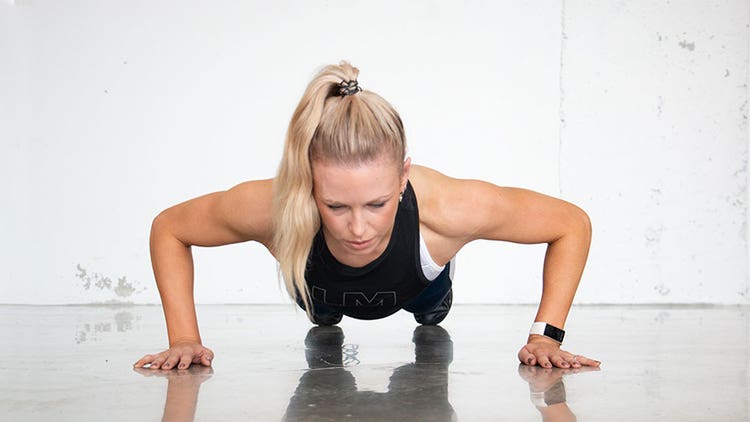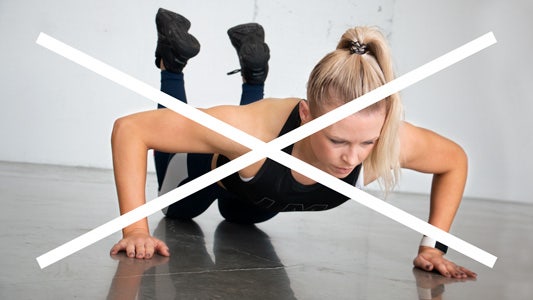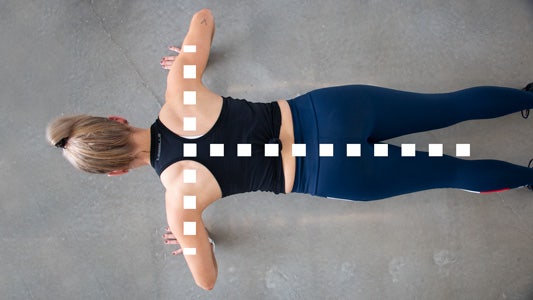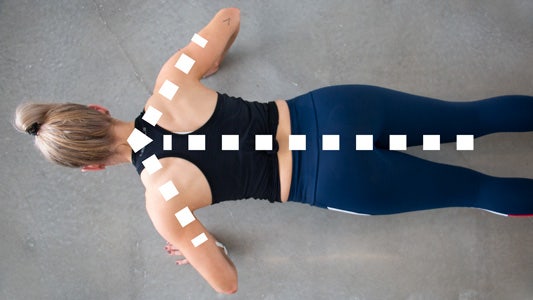Three Ways to Do Better Push-Ups

In a previous article, we learned that doing push-ups on your knees can be just as effective as doing them on your toes. Now we’re going to address a few push-up technique issues that could be holding you back from realizing your true push-up potential.
ISSUE #1: The Rocker

A lot of kids learned to do push-ups on their knees with their feet up in the air and it carries over into adulthood. It’s probably taught this way because the lower leg is thought to act as a counterbalance to the upper body (think of a seesaw) and it makes the push-up a little bit easier. But there are two big reasons why you should lose this habit immediately:
- The distribution of mass in our bodies is such that the mass of the lower leg is tiny compared to the mass of the upper body. Imagine an adult on a seesaw with a child: It’s not going anywhere! In exchange for the small gain of the counterbalance effect, you’re essentially grinding your knees into the floor. The rocking effect requires the knee joint to act as a fulcrum on the floor. The patella, or kneecap, is floating in front of the joint, and as we rock on the knee, it gets mashed around, causing discomfort and possibly pain.
- Having your knees as the only two points of contact on the floor can make you unstable. If you’re working to try to get stronger in the push-up, this instability can take your focus away from the pushing motion; instead, you are simply concentrating on not falling over. When this happens, you’re no longer isolating the push muscles and it makes it that much harder to get stronger.
Here’s the solution: Rather than keeping your feet dangling up in the air, place your toes solidly on the floor. With your toes on the floor, you’ll find that the tibial tuberosity (the head of the bone in your lower leg) actually makes contact with the floor rather than the patella. And the four points of contact (knees and toes) will make your body more stable so you can focus on isolating your arms and chest.
ISSUE #2: The T

In this position, the motion is outside the line of action of the pectoral muscles, so the anterior deltoid and muscles of the shoulder become the primary movers. Because the shoulder muscles are relatively weaker when compared to the pectorals, the force generated is less. So if you choose to do push-ups in the T position, you may find that you struggle to do push-ups on your toes, or simply tire sooner.

Here’s the solution: Instead of thinking of a T, it’s a good idea to replicate a position that’s closer to an arrow shape. When your arms are in this position, your hands are in line with the center of your chest and the motion is within the line of action of the pectorals. This allows the bigger chest muscles to take over and the shoulder muscles are used for stabilization. When the larger chest muscles are recruited, it becomes easier to do the push-up on your toes and it takes longer to fatigue.
ISSUE #3: The Eccentric
If you’re still struggling to do push-ups on your toes, give this one last thing a try. Start in a plank position with your knees off the floor and lower yourself down into the push-up. At the bottom, drop your knees to the floor and push yourself back up until your arms are extended. Lift your knees and repeat. Why does this work? It’s taking advantage of a well-known training principle: Your muscles are stronger while they are extending (eccentric) than they are while they’re contracting (concentric). On the gym floor, training the eccentric phase of a movement is called “negative” training and is commonly used to build strength once you’ve hit a plateau using traditional techniques. Follow this approach and over time you’ll find that you’ll get stronger and develop confidence in your ability to do the push-up. After a while, you’ll be able to mix in a few full on-the-toe push-ups.
If you’re really keen to master the toe push-up, give this 16-day push-up challenge a go.
If you want more tried, tested and true news from the leading edge of health and fitness, sign up to get Fit Planet insights and advice straight to your inbox.
This piece originally appeared on LesMills.com.
Photo credit: Courtesy of Les Mills